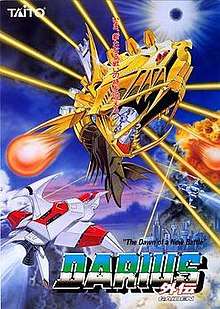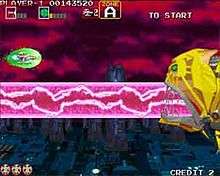Darius Gaiden
| Darius Gaiden | |
|---|---|
 Japanese arcade flyer | |
| Developer(s) |
|
| Publisher(s) | |
| Producer(s) | Hidehiro Fujiwara |
| Designer(s) |
List
|
| Programmer(s) |
Akira Kurabayashi Yutaka Nagayama Naoto Omura Hidetaka Harada |
| Artist(s) |
Hirokazu Kato Masami Kikuchi Kentaro Matsumura |
| Composer(s) | Hisayoshi Ogura |
| Platform(s) | |
| Release |
September 19, 1994
|
| Genre(s) | Scrolling shooter |
| Mode(s) | Single player, multiplayer |
| Cabinet | Upright |
| Sound | Amplified stereo |
| Display | Raster, horizontal orientation |
Darius Gaiden (ダライアス外伝 Daraiasu Gaiden) (planned to be released as Darius III[1]) is a shoot 'em up arcade game, developed and released by Taito in 1994. It is the third arcade installment of the Darius series.
Gameplay

Darius Gaiden is a two-dimensional shoot'em up. The player controls a space ship named the Silver Hawk and must guide it through scrolling stages, destroying enemies and avoiding obstacles along the way. The ship is armed with forward-firing missiles, aerial bombs and a protective force-field, all of which can be upgraded by various power-ups that are dropped by specially-colored enemies when they are destroyed by the player. New to the Silver Hawk's arsenal in Darius Gaiden is the 'black hole bomb.' When fired, the black hole bomb will create a large vortex in the center of the screen, which sucks in enemies and projectiles on the screen for a short moment, until it explodes into a powerful ball of lightning that inflicts massive damage onto every enemy on the screen.[2][3]
Another feature introduced in Darius Gaiden is the ability to capture minibosses, who appear in every stage. Each miniboss has a small, circular ball placed on them that, after receiving enough damage, will detach and float away, causing the miniboss to turn idle. If the player collects the ball, the miniboss will follow and aid the player. After a brief period of time, or the player loses a life, the miniboss will explode.[2]
Plot
Shortly after the events of the first Darius, protagonists Proco and Tiat help refugees from the planet Darius flee from the destruction caused by the Belser Army. They eventually find and set up a temporary colony on a planet named Vadis.[4] Suddenly, Belser rises again and launches a surprise attack on a spaceport on Darius, which was being used to help ferry the remaining Darians to Vadis.[5] The remaining refugees are killed, and Belser sets course for Vadis. A fleet of Silver Hawks are sent to fend off Belser, but are easily annihilated.[6] Once again, Proco and Tiat are given no choice but to fight off Belser once more.
Ports
Darius Gaiden was ported to the Sega Saturn in 1995, to the PlayStation in 1996, and to Microsoft Windows[7] in 1997-2004 (the game was ported to the PC by different companies). The Saturn and PC versions were released in Europe and North America by Acclaim and Interplay,[7] respectively. In 2006 it saw re-release on the PlayStation 2 as part of Taito Legends 2.
Reception
| Reception | ||||||||||
|---|---|---|---|---|---|---|---|---|---|---|
| ||||||||||
The Saturn version of Darius Gaiden received generally positive reviews. Though most of Electronic Gaming Monthly's four reviewers felt the game was too hard, they praised the music, the absence of slowdown, and most especially the striking graphics, and recommended the game to shooter fans as "one of the most intense [shooters] out there."[8] GamePro's Air Hendrix complimented the controls, challenge, variety of enemies, menacing bosses, visuals, and soundtrack, while criticizing the lack of selectable weapons, slowdown during busy moments, and sound effects. He made particular note of the branching level layout, saying that it extends the longevity of the game to beyond that of a rental.[11] Sega Saturn Magazine praised the multiple difficulty modes, high challenge, graphics, and multiple paths through the game. Their sole complaint was with the music, describing it as "some fat bint warbling away like an Old Spice advert."[10] Despite being written nearly a year after the game's release and giving it a low score, Next Generation's brief review was relentlessly positive, describing Darius Gaiden as "A welcome blast from the past."[9] In a 2014 retrospective, Eurogamer called the game "one of the most confident and accomplished sprite-based games ever imagined".[12]
References
- ↑ "Taito Cybercore System". arcadeflyers.com. Retrieved 11 January 2011.
- 1 2 Dollins, Josh (September 2, 2007). "Antiquated Reviews: Darius Gaiden". Defunct Games. Retrieved January 13, 2011.
- ↑ "Darius Gaiden - The Dawn of a New Battle". arcadeflyers.com. Retrieved 11 January 2011.
- ↑ Taito (1994). Darius Gaiden. Arcade. Taito. Scene: Attract Sequence.
Narration: Proco and Tiat started on a journey for new world. About that time, there were emigration ships starting from the death star, "Darius", and they arrived at a small planet, "Vadis". The years went by, and people were about to return to their native place "Darius" star.
[sic] - ↑ Taito (1994). Darius Gaiden. Arcade. Taito. Scene: Attract Sequence.
Narration: Someone destroyed the strongpoint of the migration on "Darius". Also, the transport ships being to go home are....The Demon's hand reached "Vadis" too.
[sic] - ↑ Taito (1994). Darius Gaiden. Arcade. Taito. Scene: Attract Sequence.
Narration: A company of Silver-Hawks were almost all annihilated. Having high hopes, "Silver-Hawk" sallied.
[sic] - 1 2 Daniel Erickson. "PC Gamer: Darius Gaiden". PC Gamer. Archived from the original on 18 October 2006. Retrieved 2011-01-19.
- 1 2 "Review Crew: Darius Gaiden". Electronic Gaming Monthly. No. 80. Sendai Publishing. March 1996. p. 29.
- 1 2 "Every Sega Saturn Game Played, Reviewed, and Rated". Next Generation. No. 25. Imagine Media. January 1997. p. 63.
- 1 2 Automatic, Rad (March 1996). "Review: Darius". Sega Saturn Magazine. No. 5. Emap International Limited. pp. 72–73.
- ↑ "ProReview: Darius Gaiden". GamePro. No. 91. IDG. April 1996. p. 80.
- ↑ Higham, Rupert (30 March 2014). "Darius retrospective". Eurogamer. Gamer Network. Retrieved 31 March 2014.
External links
- Official website (in Japanese)
- Darius Gaiden at the Killer List of Videogames
- Darius Gaiden at MobyGames